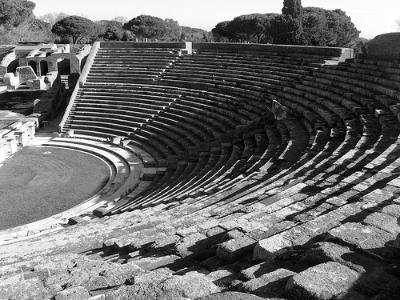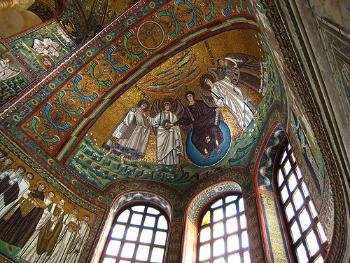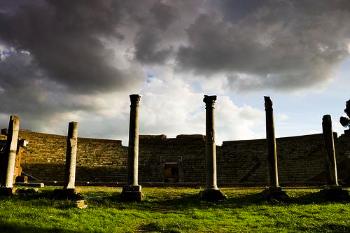Alternatives to Italy’s Top 3 Tourist Cities
 Italy is a massively popular tourist destination. There can be no getting around this fact. The most touristed cities in Italy can be agonizingly crowded in the high season, and still mildly annoyingly crowded in the low season. But as any seasoned traveler will tell you, you can find places that don’t get overrun with tourists, even in the height of the peak travel season. One of the best ways to do this is to check out these alternatives to the top tourist cities in Italy.
Italy is a massively popular tourist destination. There can be no getting around this fact. The most touristed cities in Italy can be agonizingly crowded in the high season, and still mildly annoyingly crowded in the low season. But as any seasoned traveler will tell you, you can find places that don’t get overrun with tourists, even in the height of the peak travel season. One of the best ways to do this is to check out these alternatives to the top tourist cities in Italy.
Now, I’d like to stop a moment here and say that while I’m listing alternatives to Italy’s top destinations, I’m not suggesting that by visiting (for instance) Perugia instead of Florence that you can feel like you’ve visited Florence. There is only one Florence, one Rome, one Venice (etc.), and I highly recommend seeing all of those cities at least once in your lifetime (as you’ll notice, they’re all on my list of 20 things everyone should do in Italy). But if you’ve already checked them off your list and you’re looking to dig deeper into this fabulous country, then allow me to suggest a few alternate cities for your next Italy itinerary.
Alternatives to Venice
 Venice is primarily popular for its canals – and while you’ll have a hard time finding anything quite like Venetian canals elsewhere in Italy, you can substitute a few nearby cities for other elements of what make Venice worth a visit. Namely, these cities are great for those who want to be near water, or who are looking for a great romantic destination – or both!
Venice is primarily popular for its canals – and while you’ll have a hard time finding anything quite like Venetian canals elsewhere in Italy, you can substitute a few nearby cities for other elements of what make Venice worth a visit. Namely, these cities are great for those who want to be near water, or who are looking for a great romantic destination – or both!
- Varenna – If it’s proximity to water that appeals to you, you can’t get much better than a town on Lake Como. And while there are lots of little resort towns to choose from, Varenna is a bit less popular than some of its neighbors, so you can enjoy all the perks of a lakeside town without the same crush of tourists that you’d get in, say, Como. Instead of Venice’s mazes of narrow canals, Varenna offers mazes of alley staircases. Because the town was built into a hillside, almost everything is an uphill walk from the lake – but that means you’ll find some stellar lake views once you get to the top of those hills!
- Trieste – Trieste is the capital of the Friuli-Venezia Giulia region and a relatively major port city, but it’s largely overlooked by tourists. The city center is beautiful, with plenty of gorgeous architecture to gaze at, and there’s a long promenade along the water that’s popular with locals as the place for a stroll. This isn’t a quite backwater of a town by any stretch, but there are lots of picturesque and romantic spots in the city, and because this region was once under Venetian control you may notice there’s still a Venetian feel to much of Trieste as well. And while Venice had Hemingway, Trieste had James Joyce, who lived in the city on and off for roughly a decade, writing and teaching English. Search for & book hotels in Trieste or hostels in Trieste to stay the night
- Ravenna – Arguably Venice’s main sight (after the city itself) is the stunning St. Mark’s Basilica with its Byzantine onion domes and floor-to-ceiling mosaics. But if you think the mosaics at St. Mark’s are jaw-dropping, then you’ll really love the mosaics in the churches of Ravenna. The churches in Ravenna are said to contain the finest examples of Byzantine mosaics outside of Istanbul, and as an added bonus you get a charming and relatively peaceful town to walk around in between church-viewings. Plus, after Dante was exiled from Florence, he ended up in Ravenna – which is where you’ll still find his tomb today. Unfortunately, the nearby Adriatic Sea beaches aren’t very nice, so a trip to Ravenna is definitely only a good idea if you’re not in the mood to be on the water.
Alternatives to Rome
 Rome’s main attractions are all about history – and foremost among them are the fantastic Roman ruins you can see there. But a quick overview of Italian history will remind you that the Roman empire was pretty far-reaching, so seeing Roman ruins in Italy actually isn’t something you need to go to Rome to do. These are some of the other cities in Italy with great Roman ruins. (And if it’s not necessarily Roman ruins you’re dead-set on, point yourself south and don’t stop until you reach Sicily – the Greek ruins of Taormina and Siracusa are absolutely stunning.)
Rome’s main attractions are all about history – and foremost among them are the fantastic Roman ruins you can see there. But a quick overview of Italian history will remind you that the Roman empire was pretty far-reaching, so seeing Roman ruins in Italy actually isn’t something you need to go to Rome to do. These are some of the other cities in Italy with great Roman ruins. (And if it’s not necessarily Roman ruins you’re dead-set on, point yourself south and don’t stop until you reach Sicily – the Greek ruins of Taormina and Siracusa are absolutely stunning.)
- Ostia Antica – This Roman city is actually not far from Rome, and is often done as a day-trip from the Italian capital. But if you want to make Ostia Antica and its exceptional Roman ruins more of a focal point for your trip, you can stay in nearby Lido di Ostia instead of Rome. Ostia Antica was once the port city for ancient Rome, and archaeologists have uncovered ruins dating from the 4th century BC. As an added bonus, by staying in Lido di Ostia, you not only get to check out the impressive Roman ruins, you also get to visit the town’s beach on the Tyrrhenian Sea! It’s extremely popular with Romans escaping the summer heat, so you might have better luck finding a room there outside the peak summer season. The good news is that the Roman ruins don’t care what the weather’s like – they’re always there.
- Naples – While the city of Naples itself doesn’t boast the caliber of Roman ruins that Rome does, the capital of the Campania region is home to one of the best archaeological museums in Italy and is also the perfect base from which to explore some of the most famous Roman ruins on earth. The Naples National Archaeological Museum is home to an immense collection of artifacts from the Roman empire (you’ll also find exhibits from other eras represented, but the Roman collection is considered one of the best anywhere). But if seeing Roman artifacts in a museum isn’t enough for you, then use Naples as your home base and make a day trip (or two) to nearby Pompeii and Herculaneum to see what Roman towns looked like before Mount Vesuvius buried them in hot ash. Pompeii is easily the most popular of the two, although most of what’s been excavated there is actually in Naples at the Archaeological Museum; Herculaneum is less visited. Search for & book hotels in Naples or hostels in Naples to stay the night
- Verona – The Veneto city of Verona doesn’t boast the kind of Roman ruins you’ll find at the other places above, but it’s on my list for one simple reason: you can not only tour the well-preserved Roman arena in Verona, you can (during the summer, at least) attend a world-class opera in it as well. During the summer months, you can get a ticket to see an opera in the Roman arena and, like countless people did centuries ago, enjoy a spectacle being performed for the masses. Of course, the scenes in the operas of today are significantly less bloody than the real-life ones the gladiators once “acted out,” but the thrill is no less vivid. This is especially true when you consider that you’re occupying the same marble seats people have been using since the arena was built in 30 AD. Sadly, the seats haven’t gotten any more comfortable with the passage of time, so be sure to rent a cushion on your way in to see the opera. Search for & book hotels in Verona or hostels in Verona to stay the night
Alternatives to Florence
 As the birthplace of the Renaissance, Florence is known as heaven for art lovers. And while you can’t see Michelangelo’s “David” anywhere else, there are lots of other cities in Italy with world-class art on display. Here are just a few of the places with art museums and galleries that are worth making a trip to see. (As an aside, I’m leaving Rome and Venice off this list, although both are spectacular art cities, because they’re two other destinations in this article I’m trying to give alternatives for!)
As the birthplace of the Renaissance, Florence is known as heaven for art lovers. And while you can’t see Michelangelo’s “David” anywhere else, there are lots of other cities in Italy with world-class art on display. Here are just a few of the places with art museums and galleries that are worth making a trip to see. (As an aside, I’m leaving Rome and Venice off this list, although both are spectacular art cities, because they’re two other destinations in this article I’m trying to give alternatives for!)
- Perugia – The capital of the Umbria region, Perugia is still often overlooked by tourists in the area who are hunting for their own rapturous experience under the Tuscan sun. But the amazing collection in the National Gallery of Umbria is just evidence of how important the city was to the development of the Renaissance art we know (and associate primarily with Florence) today. The gallery’s collection includes works by Piero della Francesco, Fra Angelico, and Perugino – so nicknamed because he trained and worked for many years in Perugia. In addition to being one of Perugia’s favorite sons, Perugino is also known for being the great Raphael’s teacher. And as if this excellent collection of paintings wasn’t enough, Perugia itself is a pretty medieval hill town. Search for & book hotels in Perugia or hostels in Perugia to stay the night
- Milan – While Milan isn’t exactly off the tourist radar, there are two reasons why art lovers will want to make this city (best known for fashion and banking) a stop on their Italy trip. One of the reasons is quite well-known, but the other is too often forgotten entirely. Leonardo da Vinci may be closely tied to Tuscany, but he made his home in Milan for years, and left arguably his most famous fresco in the city. Leonardo’s “Last Supper” is easily one of the best reasons to visit Milan, despite how difficult it can be get tickets. But when your 15 minutes with “The Last Supper” are over, don’t leave Milan without also stopping at the excellent Pinacoteca di Brera Gallery. The gallery’s collection includes masterpieces by Caravaggio, Francesco Hayez, Piero della Francesca, Mantegna, Rembrandt, Raphael, Bellini, and Tintoretto, among many others. Search for & book hotels in Milan or hostels in Milan to stay the night
- Padua – This Veneto city, called Padova (PAH|doh|vah) in Italian, isn’t one to keep all its artistic treasures in one place. In fact, the city itself is something of an artistic treasure. The famous architect Palladio was born in Padua, and his incredible work can be seen throughout much of the region. Additionally, because the city has long been the home of a major university, it’s also been a popular city with artists – some of the artists who have spent significant time in Padua include Donatello, Giotto, and Fra Filippo Lippi. There is a beautiful series of frescoes by Giotto in the Scrovegni Chapel, the main attraction in Padua, and an equestrian statue by Donatello graces the piazza in front of St. Anthony’s Basilica. For a bit more of the organic side of art there’s also the UNESCO-protected Botanical Gardens of Padua.
>> For more ideas for your itinerary, check out my suggestions for the perfect 2-week trip to Italy. You’ll find oodles of good tips throughout this whole Italy travel guide, but if you poke around and you still can’t find what you’re looking for, by all means send me a note!
original photos, from top to bottom, by Alaskan Dude, sjmcdonough, rayced, and trinchetto